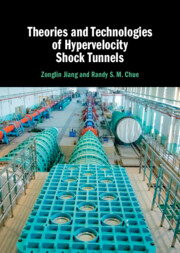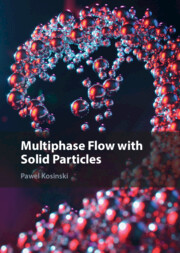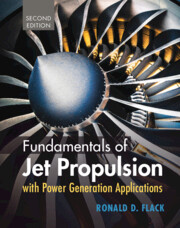Refine search
Actions for selected content:
5487 results in Thermal-fluids engineering
1 - Basic Concepts and Scope of the Book
-
- Book:
- Multiphase Flow with Solid Particles
- Published online:
- 05 October 2023
- Print publication:
- 19 October 2023, pp 1-5
-
- Chapter
-
- You have access
- Export citation
4 - Energy Transfer between a Fluid and a Rotor
-
- Book:
- Principles of Turbomachinery in Air-Breathing Engines
- Published online:
- 18 November 2023
- Print publication:
- 19 October 2023, pp 112-230
-
- Chapter
- Export citation
4 - Tangential Contact
-
- Book:
- Multiphase Flow with Solid Particles
- Published online:
- 05 October 2023
- Print publication:
- 19 October 2023, pp 86-114
-
- Chapter
- Export citation
2 - Flow of a Single Particle
-
- Book:
- Multiphase Flow with Solid Particles
- Published online:
- 05 October 2023
- Print publication:
- 19 October 2023, pp 6-43
-
- Chapter
- Export citation
10 - Radial-Inflow Turbines
-
- Book:
- Principles of Turbomachinery in Air-Breathing Engines
- Published online:
- 18 November 2023
- Print publication:
- 19 October 2023, pp 467-547
-
- Chapter
- Export citation
Frontmatter
-
- Book:
- Multiphase Flow with Solid Particles
- Published online:
- 05 October 2023
- Print publication:
- 19 October 2023, pp i-iv
-
- Chapter
- Export citation
6 - Radial Equilibrium Theory
-
- Book:
- Principles of Turbomachinery in Air-Breathing Engines
- Published online:
- 18 November 2023
- Print publication:
- 19 October 2023, pp 269-297
-
- Chapter
- Export citation

Theories and Technologies of Hypervelocity Shock Tunnels
-
- Published online:
- 12 October 2023
- Print publication:
- 26 October 2023

Multiphase Flow with Solid Particles
-
- Published online:
- 05 October 2023
- Print publication:
- 19 October 2023

Fundamentals of Jet Propulsion with Power Generation Applications
-
- Published online:
- 01 September 2023
- Print publication:
- 10 August 2023
-
- Textbook
- Export citation
Contents
-
- Book:
- Fundamentals of Jet Propulsion with Power Generation Applications
- Published online:
- 01 September 2023
- Print publication:
- 10 August 2023, pp ix-xx
-
- Chapter
- Export citation
Reviews
-
- Book:
- Fundamentals of Jet Propulsion with Power Generation Applications
- Published online:
- 01 September 2023
- Print publication:
- 10 August 2023, pp iv-iv
-
- Chapter
- Export citation
Dedication
-
- Book:
- Fundamentals of Jet Propulsion with Power Generation Applications
- Published online:
- 01 September 2023
- Print publication:
- 10 August 2023, pp vii-viii
-
- Chapter
- Export citation
Part II - Rotating Components
-
- Book:
- Fundamentals of Jet Propulsion with Power Generation Applications
- Published online:
- 01 September 2023
- Print publication:
- 10 August 2023, pp 251-412
-
- Chapter
- Export citation
Appendix C - One-Dimensional Compressible Flow
-
- Book:
- Fundamentals of Jet Propulsion with Power Generation Applications
- Published online:
- 01 September 2023
- Print publication:
- 10 August 2023, pp 607-627
-
- Chapter
- Export citation
Copyright page
-
- Book:
- Fundamentals of Jet Propulsion with Power Generation Applications
- Published online:
- 01 September 2023
- Print publication:
- 10 August 2023, pp vi-vi
-
- Chapter
- Export citation
4 - Turbomachinery Fundamentals
- from Part II - Rotating Components
-
- Book:
- Fundamentals of Jet Propulsion with Power Generation Applications
- Published online:
- 01 September 2023
- Print publication:
- 10 August 2023, pp 253-266
-
- Chapter
- Export citation
Appendix M - Introduction to Suite of Gas Turbine .exe Programs
-
- Book:
- Fundamentals of Jet Propulsion with Power Generation Applications
- Published online:
- 01 September 2023
- Print publication:
- 10 August 2023, pp 693-697
-
- Chapter
- Export citation
8 - Diffusers and Inlets
- from Part III - Nonrotating Components
-
- Book:
- Fundamentals of Jet Propulsion with Power Generation Applications
- Published online:
- 01 September 2023
- Print publication:
- 10 August 2023, pp 415-454
-
- Chapter
- Export citation
References
-
- Book:
- Fundamentals of Jet Propulsion with Power Generation Applications
- Published online:
- 01 September 2023
- Print publication:
- 10 August 2023, pp 698-701
-
- Chapter
- Export citation
